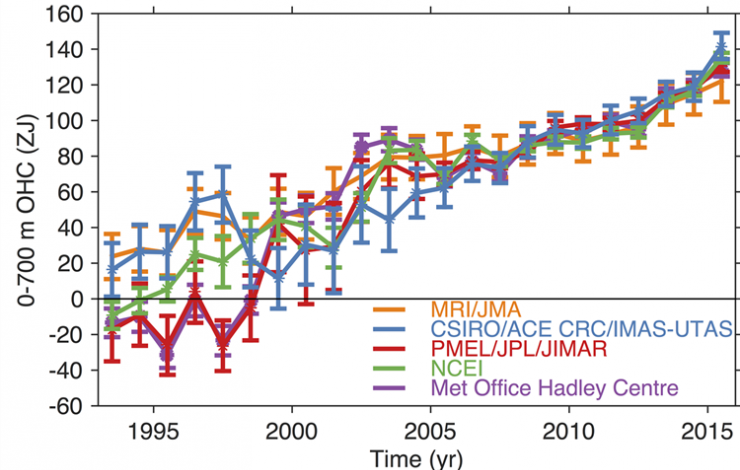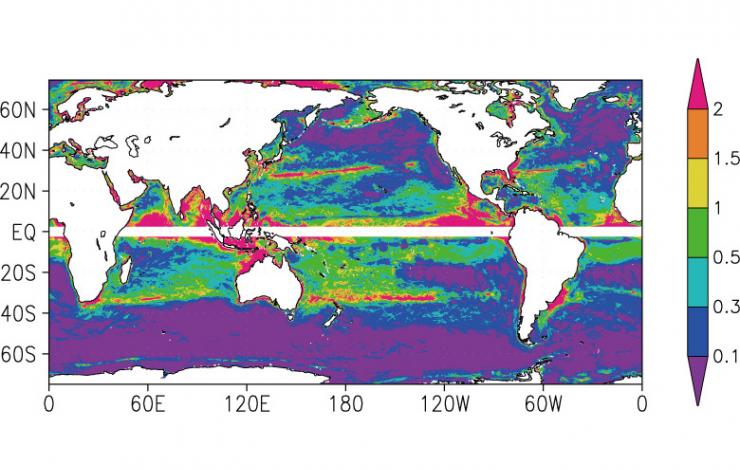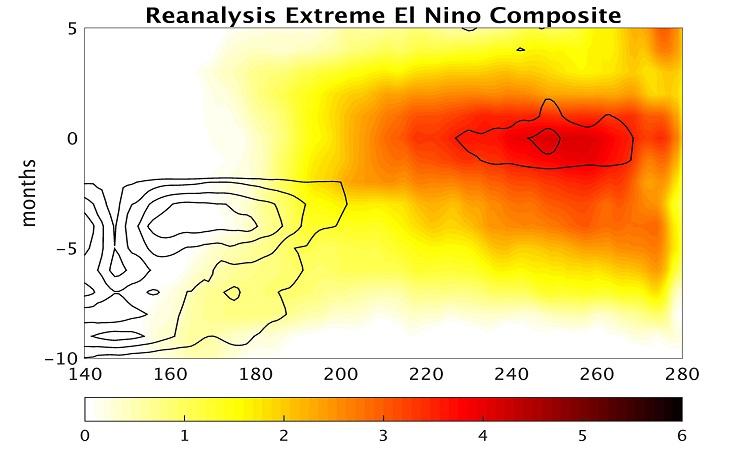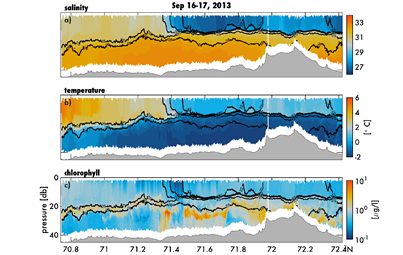Feature Publication Archive

Figure 3.6(a): Time series of annual average global integrals of in situ estimates of upper (0–700 m) OHCA (1 ZJ = 10²¹ J) for 1993–2015 with standard errors of the mean.
Every year NOAA leads a team of international scientists in issuing a report on the state of the climate in the year just passed, published as a supplement to Bulletin of the American Meteorological Society. Nine Federal, JISAO, and JIMAR scientists resident at PMEL co-authored four of twelve sections in the Global Oceans chapter and one section in the Arctic chapter for the State of the Climate in 2015 report, published in July 2016. In addition, Dr. Gregory Johnson served as lead editor of the Global Oceans chapter and participated in the media roll-out event.
Dr. Johnson’s... more »

Global map of the ratio of the mean surface geostrophic shear stress magnitude (|τp|) to the mean wind stress magnitude(|τ0|): R = |τp|/|τ0|. Where R is greater than 1, frontal effects dominate the classic "Ekman" response to wind forcing. From Cronin and Tozuka (2016).
Cronin, M.F., and T. Tozuka (2016): Steady state ocean response to wind forcing in extratropical frontal regions. Scientific Reports, 6, 28842, doi:10.1038/srep28842.
Wind forcing is fundamental to the ocean circulation. According to the classic “Ekman” theory developed in the early twentieth century, wind-induced steady flow spirals to the right of the wind stress in the Northern Hemisphere and to the left in the Southern Hemisphere, resulting in a net wind-forced “Ekman” transport that is 90 degrees to the right of the wind stress in the Northern Hemisphere and to the left in the Southern Hemisphere. This theory, however, assumes that the near-surface ocean is uniform in density (i.e., has no fronts). In frontal regions the surface “geostrophic”... more »

Composite evolution of extreme El Niño events in WWBs (contours) and anomalous temperature (colors). One WWB early in the year warms the central Pacific making additional WWBs more likely. Many WWBs are necessary to trigger an extreme El Niño event.
Levine, A.F.Z., F.-F. Jin, and M.J. McPhaden (2016): Extreme noise–extreme El Niño: How state-dependent noise forcing creates El Niño-La Niña asymmetry. J. Climate, doi:10.1175/JCLI-D-16-0091.1
Published online. http://journals.ametsoc.org/doi/10.1175/JCLI-D-16-0091.1
A major unanswered question about El Niño-Southern Oscillation (ENSO) is why the largest El Niño events are stronger in magnitude than the largest La Niña events. This paper examines one of the leading hypotheses to explain this asymmetric behavior; namely, that westerly wind bursts (WWBs) create conditions to promote additional WWBs, and the sum total of all the WWBs that occur during the initiation and growth of an El Niño event impacts the eventual magnitude of the event. WWBs are short episodic bursts of westerly winds that occur in the opposite direction of the normal trade winds.... more »

Studying where some of the smallest organisms in the ocean are located can be difficult when they are found beneath the surface. In the late summer and early fall, phytoplankton in the Chukchi Sea are usually found in thin, patchy layers that can only be observed using shipboard surveys. In a collaborative effort between PMEL’s EcoFOCI group and the University of Alaska Fairbanks, scientists were able to map the distribution of subsurface phytoplankton using a novel high-resolution towed instrument platform. A significant fraction of the phytoplankton biomass is contained in these layers,... more »
Fassbender, A.J., C.L. Sabine, and M.F. Cronin (2016): Net community production and calcification from 7 years of NOAA Station Papa Mooring measurements. Global Biogeochem. Cycles, 30, doi:10.1002/2015GB005205.
Ocean Climate Station Papa is a time series site located in the eastern subarctic Pacific where atmospheric carbon dioxide is absorbed by the ocean. A moored buoy has been measuring the carbon content of both the surface ocean and surface atmosphere, along with numerous other oceanic and meteorological parameters, at this site for approximately 9 years. This area is notorious for having consistently low chlorophyll levels (a proxy for marine algae) and high concentrations of organisms that make hard shells out of calcium carbonate, commonly referred to as calcifiers, providing an... more »


